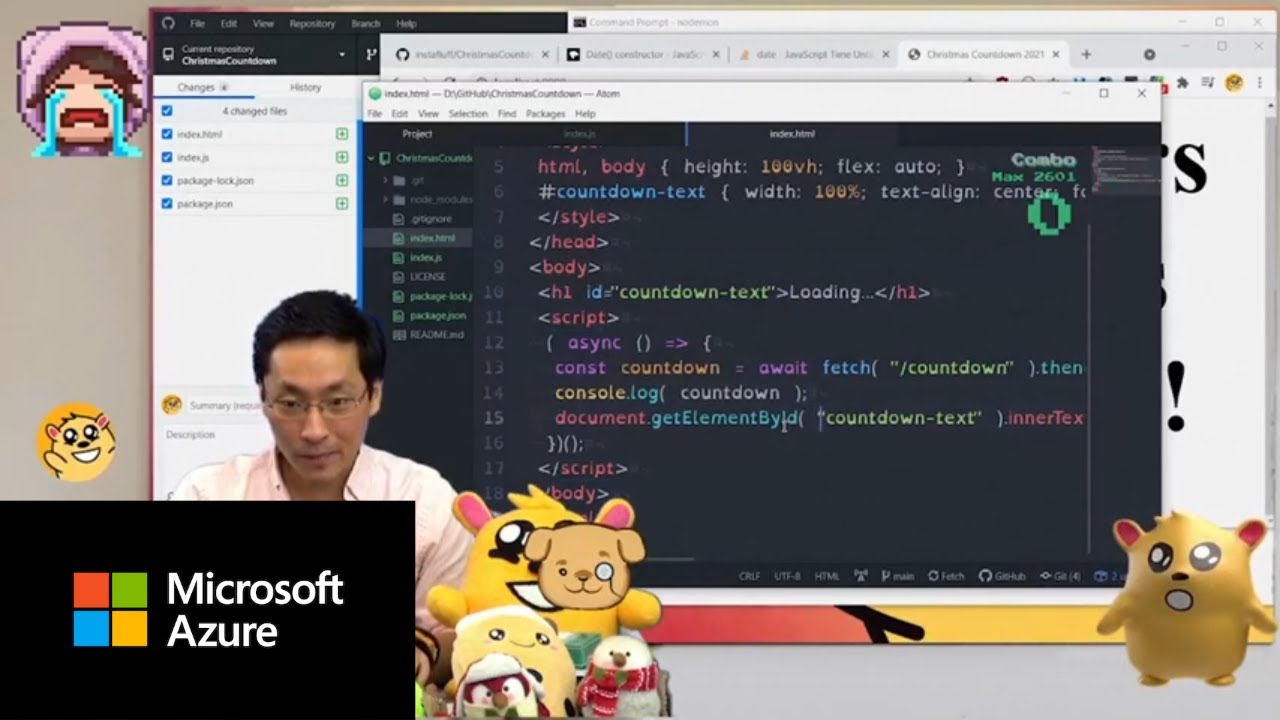In IT Consulting
Kubernetes on Azure - read the full article about Kubernetes tutorial, IT Consulting and from Microsoft Azure on Qualified.One

Youtube Blogger

[MUSIC] >> Today, we have a really special sponsored stream from Microsoft.
Thank you to the Azure team.
Were going to build an app completely from scratch, a NodeJS app, and then well deploy it to Azure, deploy it to the Cloud.
Then were going to put it onto Kubernetes and put it onto Azure.
Ill show you how to do all of that without even needing to have Docker on your computer or anything. Its going to be really cool.
But first off, I guess were going to create a repository for our project.
Its going to be a very, very simple app.
This is going to be a Christmas countdown.
Were going to have a repository and its going to do, Christmas Countdown NodeJS App, and well add a README, add a gitignore, and the gitignore is going to be a Node app, and then I can create repository.
Lets initialize the Christmas countdown very well. Thats fine.
Christmas countdown app for NodeJS, and entry point, test command, Git repository, keywords.
I will say Christmas countdown, NodeJS, JavaScript, and Instafluff, and then author, MIT License, oh, yeah.
Yes. I wish I had Nano because what I like to do on Nano is then Id just do a Nano thing and then I might go webweb, and then run, and then thats all I need to create for it.
Except in here what Im going to do is, Ill actually want to have an API for it, so web.APIs will say countdown, body, and options.
We need to have the timer.
We need to know how much time there is between now and Christmas and then return that in the API.
What I want to know is Christmas, I want to find JavaScript date theory.
Here we go. This is perfect.
This is what we needed per year, December 25th, 2021, per year, and there we go.
Theres Christmas, and then we have today is just this.
I just want to return this, and so Im going to return it as a JSONObject, and be like, Christmas.
Actually, I can just return this and then today.
TimeUntil. This is going to diff.
Run this on port 8080, and then localhost 8080 and then countdown.
It should give us, wow, its tiny.
TimeUntil is, I think this is in milliseconds.
What Im going to do is, Im going to compute this.
Time until, and I will do milliseconds is diff, and then timeUntil in seconds is going to be diff divided by 1,000 and timeUntil in minutes, is going to be this divided by 60,000, 60 minutes times 60 seconds.
TimeUntil days is going to be diff and then its going to be 24 hours times 60 times 60,000. That should be it.
[FOREIGN].
>> Oh, yeah. Now, we have time to milliseconds.
We have 42 days until.
Actually, I should center horizontally though. Let me do that.
To center horizontally, in the alignment and goes, this is 100 percent.
You say, Text-align and then you go "Center", and then.
[FOREIGN] Check it out. Would you look at that.
The inner text is going to be, let me do this.
Is it too fixed too? I forgot to close it, 42.54 days until Christmas per year until now.
I can set the font size on this to be something ridiculously big, 128.
When we do minutes, diff minus its going to be days times, no days times 60 because its 60 minutes, remove that, and then we have seconds is going to be equal to but without the 60 days times 60 times 60 plus minutes times 60.
Now, we can format this.
We can be like 42 days, something hours etc, until Christmas, so then the countdown hours, and then we have minutes, and then we have seconds, and then milliseconds.
Count mills, 42 days, 12 hours 37 minutes, 52 seconds, and 973 milliseconds until Christmas.
Maybe what Ill do though, I should do this as a timer; command, set, set interval command, and then this, and then go like this.
I guess this is good enough for now.
With that, now we have this app.
We have it, it works, and its here.
Now, all we got to do is to get it onto Azure Kubernetes.
Im going to log in to the portal Azure.
Here what I have to do is Ive to find DevOps, create a cluster.
Lets do it. Where do we go? Lets find, and then Ill put this on Instafluff, thats fine.
"Standard", Christmas countdown.
"Resource group", actually, I should create a new resource group because then itll make it really easy for me to to delete it.
Ill call this "Christmascountdown" as a resource group.
Its created, deployment in progress.
Now, were going to connect this to Azure Pipelines.
Its pretty easy. Its pretty nice.
You just do start free or start with GitHub, and then even the pricing, theres the free pricing as you saw earlier free for open source projects.
"Start free" over it. Come here.
That was a go, we get a signed in. I guess that works.
S, X, D, Y, K, K, D, continue. Youve got it working.
Check this out, your result, 42 days, 12 hours, 25 minutes, eight seconds until Christmas.
This is what were going to do, build and push the image to Azure Container Registry, deploy to Azure Kubernetes Service.
We say files name, I think its signed into this, enter into account, and space "Christmascountdown".
Everything Im just calling "Christmascountdown".
Container registries, and then well create one and then pay-as-you-go resource group is going to be "Christmascountdown" and then enter the name.
This is "Christmascountdown" everything.
Great. The pipeline is instafluff.
Christmascountdown, and then, yeah, show more information.
Here it is "Project Settings", and then "New pipeline", and select "GitHub" and then we select our repository.
Were going to select this "Christmascountdown", then we can review the pipeline.
Then "More Actions". Yeah, this is fine review.
It has all the things and then do Run and then it creates the pipeline.
There isnt much that it has to do.
Its just to create this pipeline and then thats it.
Merely run, "Stages" "Build stage" and its queued.
It might be working. It might be doing something.
I think thats all I have to do.
I just have to create a new one.
It wants a Docker file.
We might have to create our own Docker file but once we do that then it should be fine.
The Docker file is going to be on the main thing here.
Im going to find a template Docker file that we could use, thats going to be easy.
Heres one, super-easy.
Lets put it in there and package this on your end and then install TypeScript latest.
We dont really need TypeScript, do we? Yeah, we dont need that. Then on the production and then npm, Start Expose 8080 because we run it on port 8080.
Copy everything from that.
[FOREIGN] Okay, a minute. Now, we did that, and then it picks it up but were about to put it onto Cloud here.
We just put in the Docker file so now its building and we can see it in progress and then well see whats going on.
Here it is and it says, "Deploying." Its building.
Its going to build and then deploy and then the deploy request, and hopefully, that should be it.
The initials does this.
I dont have Docker installed on my computer.
You dont need to do like image building things or anything on your own computer or locally.
You just set the thing up and youre like point it to this repository and then checked in my Docker file and there you have it.
But its deploying.
Its deploying to the Kubernetes cluster and do the thing and that it was created it and, it deployed.
Finalized, it finished all.
Do you know what this means? Its running.
What? We did it just like that and this is cool.
This is damn cool because we went from our local Christmascountdown servers thing thats running on port 8080 on this computer here, our localhost and then we just use the Microsoft Azure Portal to then create a Kubernetes cluster and a Container Registry.
We went here and went to the Azure DevOps and then created new pipeline that connected to our GitHub repository and then it just automatically picked it up and configured all the settings to connect up to the Kubernetes cluster.
I cant believe it, it and works. Its so cool.
There you have folks. Thats all you got to do, to do Kubernetes is on the Cloud.
[MUSIC]
Microsoft Azure: Kubernetes on Azure - IT Consulting

